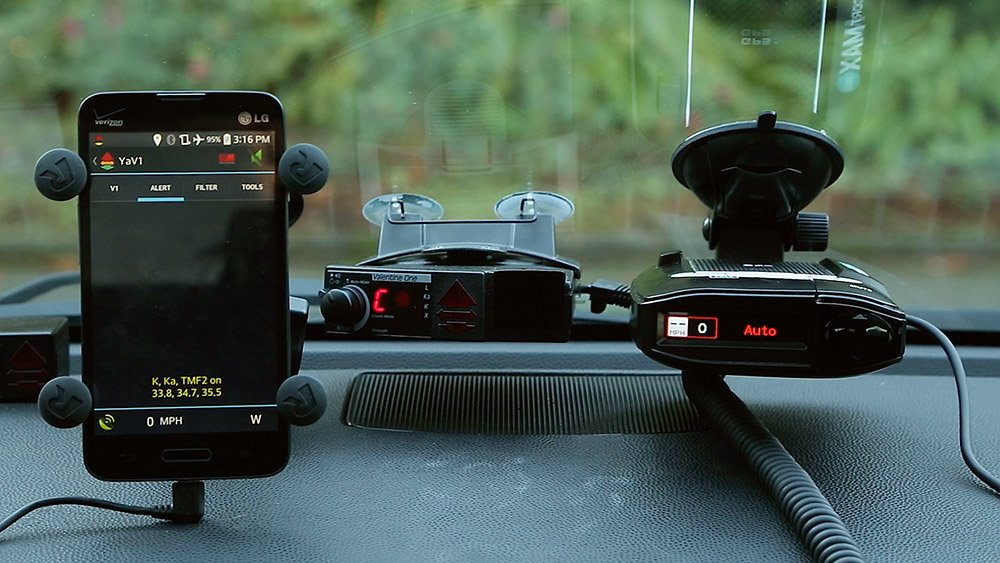
Valentine One vs. Escort Max360? Both are high end radar detectors. Both have arrows. Both cost hundreds of dollars.
The V1 has been around for ages and the main trick up its sleeve is arrows. Valentine has held a patent on the feature and Escort has long said that you don’t need arrows if you have better filtering because the detector will stay quiet if it’s a false alert and beep if it’s real. Well Valentine’s patent on arrows has expired and lo and behold, Escort has brought arrows over to their jack-of-all-trades detector, the Max2, and called it the Max3..60. The Max360 is loaded with bells and whistles and copies of many of the features (including the arrows) from the V1. Is it a better radar detector though? Let’s find out.
Valentine One vs. Escort Max360 Comparison
Overall Comparison (Cliff Notes)
The V1 is a very solid performer, but it doesn’t have a whole ton of modern features built in such as a standalone package. On its own it doesn’t give you the ability to unlock the full potential of the detector either. It will offer good range and a lower price than the 360, but to get maximum performance from the detector and really help take care of the annoying false alerts, you’ll need to buy not only a V1 ($400), but also a bluetooth module ($50) and pair it with an Android phone like this one if you don’t have one already. To get it set up properly, it will take more initial setup and configuration, plus it relies on multiple apps like YaV1 and Waze, but once it’s all set and done, you have a pretty awesome bit of kit that is more refined and offers better performance than the Max360.
The Max360 can do all the same sort of things, but in a plug-and-play package that works out of the box with little to no setup required. If you want all the bells and whistles and have the detector do it all for you, especially if you’re a bit intimidated by technology, the Max360 is a better choice. It retails for $650 and you can buy the Max360 here. While the 360 won’t have the range of the V1, you’re getting a much more convenient and integrated detector, you don’t have to constantly rely on your phone, and you’ll have a much easier to use overall package. It’s not a favorite among radar detector enthusiasts, but it’s a good choice for the everyday driver who just wants a detector that they can put on their windshield and go.
Buy the one that suits your temperament, or perhaps even another detector I also recommend if you don’t need the arrows. The V1/YaV1 and Max360 share many of the same features, though they implement the features differently and so you’ll see some variation in the level of refinement and effectiveness of the various features.
Background & History
The V1 has been a popular radar detector for many years now and has been consistently upgraded throughout the years. (Lots of people don’t realize this, thinking that all V1’s are equal and since the V1 has had the same design for many years, the resale value is very high, even with older versions of the detector. Imagine if the original iPhone sold for nearly the same price as the latest and greatest model…) In any event, one of the main features and selling points has always been the arrows. One of the unique abilities that the V1 offered was to be able to locate the threat thanks to its arrows. While this doesn’t always mean the difference between a ticket or not, it many situations it does help and it means that the V1 allows for an unparalleled degree of situational awareness.
Escort has taken a different approach. Since Valentine has held the patent on the arrows, Escort decided to focus on better filtering out the false alerts via different GPS related tricks. Their detectors have been given the ability to learn where the fixed false alerts are located around you from sources like speed signs and automatic door openers from grocery stores and drugstores, memorize them, and then automatically begin locking them out over time so the false alerts are muted in the future. Escort’s stance was that arrows aren’t as necessary if the detector just filters the falses out altogether and only beeps if the signal is real.
Over time there’s been a blending between the two schools of thought. Enthusiasts have developed a third party app for the V1 (YaV1) that gives it the same GPS tricks to learn and automatically filter out the false alerts the way that the Escorts could do. Once Valentine’s patent on the arrows expired in 2011, Escort decided to close the gap and take away the V1’s primary competitive advantage and so now they’ve brought arrows over to their automatic false reducing GPS based detectors. So now we have two very similar products that have not only taken the best features from the other, but have also tried to improve upon the other’s approach of arrows or filtering. Similar features, but they’re not the same.
If you read online, you’ll see a lot of enthusiasts who aren’t big fans of the Max detectors to say the least, and justifiably so. I’ve been one of them. Escort has been in the pursuit of profit over quality lately and charges people an arm and a leg for poorly constructed products that perform worse than the competition and then they try to cover it up with deceptive marketing and lies claiming that it’s the best performing detector around. So there’s now a lot of bad feelings towards the company and the detector at this point and the company’s reputation has been steadily declining. Nonetheless, BS marketing aside, the detector has quite a bit to offer in spite of the advertising and so we’re going to put aside the hype and BS and instead look at the detector itself in a systematic and objective way.
Additionally, V1 only sells direct, so some people who sell radar detectors online may be financially incentivized to promote a product they can sell over one they can’t. I’ll tell you right now that I will link you to Amazon where you can buy the Max360 and I do make a cut when you buy the detector. I don’t make anything when you buy the V1 and I’ll even steer you away from buying a V1 on Amazon because you’ll pay more than full retail and get no warranty. Nonetheless, I strongly believe that you deserve to make the decision to buy what you feel is the best for you, not what any reviewer or salesperson wants you to buy for the sake of their wallet. There are also several other radar detectors I would recommend that you check out before making a decision. Keep all of this in mind when you read not only my information, but also the other information available on the internet. So with all that said, let’s take a look at the various aspects of the radar detectors themselves.
Programming
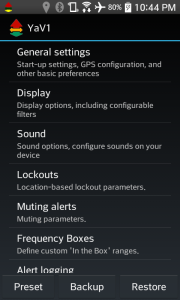
This is one of the biggest differences between the two detectors. The Max360 is essentially plug and play with a variety of simple settings to adjust while the V1 requires additional components and apps in order to have the full functionality and gives you a ton of options to configure. I have tutorials and setup guides available to help you set up both detectors. For more information, watch this video on how to set up the Max360 or watch these videos to learn how to set up the V1/YaV1.
The Max360 is fairly plug and play and its programming options are mostly aesthetic. You can change the color of the display, the arrows, the way alerts show up on screen, if it displays MPH or KPH, and so on.
The V1 offers much more fine tuned control. You can adjust the frequencies that it sweeps or not, enable some advanced muting options, see all the relevant information for every single signal, and even create several different profiles for different settings that you can switch between on the fly such as turning the filters on/off for better performance or better filtering depending on where you drive. It requires more knowledge and understanding and again you’ll need a phone and bluetooth module (plus potentially extra hardware like a phone mount, phone charger, and power cable), but you have more fine tuned control with this package. That may be more than what some people want and it may be exactly what others want. Up to you.
Radar Detection Performance
This is always the first thing we should look at. Performance. How well does a radar detector detect radar? That’s its main job, afterall. It’s not the only thing that matters, but it is one of the most important things and the more range we get, the more warning we get to police radar, especially in more challenging terrains or if instant on is being used. Things like filtering are important too of course, but we’ll start with range.
V1’s and Max’s have been tested many many times together. The Max2 is a Max with bluetooth. The Max360 is basically a Max2 with a rear antenna and some cosmetic changes plus an improved blind spot filter. In every single test, the Max360’s performance has been shown to be identical to the previous gen Max’s. This makes sense when you look under the hood. When some of us opened our Max360’s, we saw that it had the exact same front horn (antenna) as the Max2 and the same class FPGA and DSP chip. In short, same foundation of hardware. They added a rear antenna, sure, but the front radar detection abilities are otherwise the same. This would explain why the Max360 returns the exact same results as the Max and Max2 every time we test it. For example, see here.
My last few radar detector tests were done before the 360 came out and given that it’s just another rehash of the previous gen Max’s, I’m going to show you the results from one of my previous radar detector tests that featured a V1 and a Max2, not a Max360. I know it’s not the same detector, but the Max2’s performance will be representative of the Max360’s performance.
Full discussion of this test available here: https://www.rdforum.org/showthread.php?t=44373
So as you can see, the Max generally trails just behind the V1. Depending on the radar gun and terrain, the Max can sometimes perform on par V1, but the V1 generally exceeds it. Testing multiple copies of V1’s and Max’s, I’ve noticed more consistency in the V1’s than the Max’s. For example, you can see some additional tests where it performs on par with other detectors in this test, tests where it had freakishly good runs like in this test, and tests where it had very poor performance like in this test and this test. So there’s more inconsistency with the Max series detectors, but the general trend is that it performs on par or below a V1.
The Max360 is now the most expensive windshield mount radar detector on the market, but you’re not paying for performance. I think this is something that a lot of people have trouble accepting. Why is it that detectors that cost hundreds of dollars less can outperform this detector? That’s a big sticking point for the 360. You’re not paying for all out raw performance. You’re paying for ease of use, convenience, additional false alerting filtering, and having everything done for you.
Now that doesn’t mean that if you put a Max on your windshield that you’re suddenly going to get tickets left and right. You’ll still get an adequate level of protection against most threats in general. It just means that you don’t have the same level of protection you would from a better performing detector, particularly in tougher situations. It’s why if you do mostly highway driving, especially in rural areas where you don’t have as many falses to contend with, you’ll be better suited with a detector like the Redline that offers more performance for the money rather than focuses on filtering in town. If you do a mix of both, or especially if you do a lot of city driving, then the 360 will be a more suitable choice and going for a detector with better false alert filtering that doesn’t cry wolf all the time is a good choice.
Laser Detection
This is an area where you’ll see a difference, but it doesn’t really matter. Laser is something else unchanged with the Max360. It has the same not-so-great laser sensor used in the previous gen Max’s. However, laser sensitivity isn’t a big deal in a radar detector because it’s essentially just a ticket notifier (if it even goes off in the first place). Unlike laser jammers which let you do something about laser to avoid a ticket, the same isn’t true with a laser sensor.
The V1’s laser sensor is very best on the market. It’s sensational. At the same time, it’s also somewhat llacking in sufficient filtering so it’s also going to give you a fair amount of false alerts. It’s for this reason that I shut laser off on my V1 entirely and let my jammers handle everything.
Here’s a quick laser test with the Max360, Redline, Radenso Pro SE, Max2, and Redline. Now normally tests like this are a terrible idea when doing radar detection since the detectors will interfere with one another. When it comes to laser detection, that doesn’t apply and so it’s a different story. In any event, in this test we start by driving away from the shooter using a Kustom ProLaser 4 lidar gun back behind us. The V1 goes off first, then the 360. The Max2 is silent and this made me think that the Max360 did shockingly well until I looked further. The shooter was off to the left side of the vehicle, the same place where the rear laser sensor is (see that popup thing on the top left of the detector?) so it had the best shot at picking up laser… something tough when the detectors are down below the rear window. In any event, the latch is fairly long so the signal doesn’t go away until after I turn around to face the laser gun. The V1 keeps going off and then the Redline goes off. The Redline has a good laser sensor. Not quite as good as the V1, but still good and better filtering. You’ll then see the Radenso go off and then eventually the Max2 and Max360 go off at the same time. From the front I asked the shooter to aim at my front plate in the center of my vehicle. In any event, you can see for yourself.
Full discussion of this test available here: https://www.rdforum.org/showthread.php?t=48757
False Alert Filtering
This is an area where both options shine. The nuances are somewhat different, but they share many of the same features. The V1 depends on YaV1 again here for GPS lockouts on Android or V1Driver for iOS. It has a very good blind spot false filter, but the Max360 has some cool tricks up its sleeve on this one. They each share the same features here, but each one operates differently so let’s look at them individually.
GPS Lockouts
GPS lockouts are an awesome feature. I feel like I’ve gotten a bit spoiled with this feature and don’t want to use a radar detector anymore without it. It’s too useful around town for quieting false alerts. Basically it uses a GPS chip to learn where your false alerts are (based on their frequency and location) and then you lock the signal out and it gets automatically muted next time you come by. Very handy.
Mike Valentine, the guy who makes the V1, isn’t a fan of GPS lockouts as he explains here. He contends that this has the possibility of also locking out a police officer too which is true and can happen. It’s happened to me a few times. He suggests that we take advantage of low speed muting instead which I disagree with. Low speed muting helps, but I think it’s a complement to lockouts, not a replacement for it, especially for well implemented lockouts. Here’s what I mean…
Escort’s implementation of lockouts are geared towards quietness. YaV1’s lockouts are a bit chattier at first, but they’re geared towards safety. Escort’s lockouts learn which frequencies are in which locations and lock out EVERY signal that matches those two criteria. If you have a second radar gun that later shows up from a police officer that is shooting his radar gun near a supermarket, there’s a good chance that your detector will inadvertently lock that signal out too. You can see an example of that in this video.
Now the solution to that that was created for YaV1 was to keep track of not only the frequency and location, but also the number of signals in that area. If the lockout is for only one signal, if a second signal shows up, alert! You can see an example of that in action here:
When I drive in areas where K band is used in shopping areas, I prefer YaV1’s technique for lockouts for obvious reasons. It’s more advanced and sophisticated and is specifically designed to help minimize the chances of lockout out a LEO. It’s still possible, but far less likely.
Now on the flipside, YaV1’s lockouts are chattier. What I mean is that because of the additional analysis that it does, it takes longer to create the lockouts initially and sometimes you can go through a lockout area and get alerted to a new signal due to its tighter tolerances. A signal may drift in frequency over time due to weather and YaV1 is more likely to alert you to a signal that has been previously locked out for that reason.
So YaV1’s lockouts are safer and Escort’s lockouts are quieter and are better at remaining quiet. I prefer driving around more and giving YaV1 more time to create a set of lockouts, but there are times, especially when I live in a part of town where K band isn’t in use that I want lockouts to be quiet and stay quiet and I don’t need as sophisticated of a lockout implementation.
Blind Spot Filtering
These are some of the most annoying sources of false alerts out there these days and it’s plaguing every single radar detector on the market. In short, cars have a lot of new safety systems that are being built into them like collision avoidance systems and blind spot monitoring systems. Some of them operate on the same frequencies as police radar and are very tough to filter out. No detector can filter them out entirely.
Generally the main technique for filtering these false alerts out has been to simply block any brief signals. Filters like TSR and TMF that were originally designed to filter out traffic sensors on the highway can also be used to filter out some blind spot systems. They basically introduce a filter that says that any short duration alerts should be filtered out. This helps quiet the detector down at the cost of missing potentially brief signals plus reduced detection range. Take a look at the following test with a variety of different detectors. On top you’ll see the detectors run in their unfiltered modes. Underneath you’ll see the same detectors run again, this time with Auto Mode and TSR enabled. Look how much detection range drops.
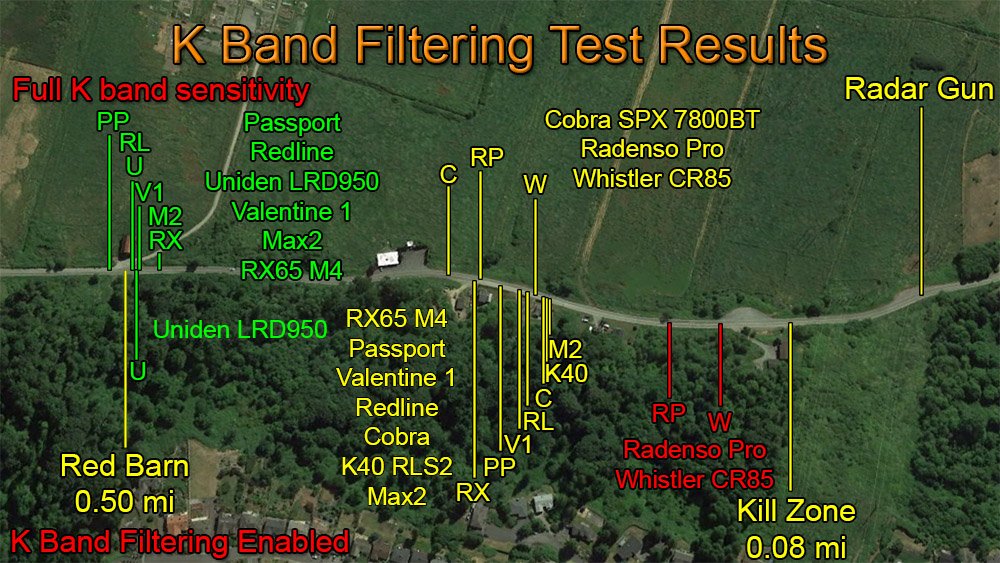
The only exception was the Uniden. Earlier firmware versions of the LRD950 were able to filter out some blind spot vehicles without requiring the range-killing penalties of TSR. Very cool. The only other detector that could do this is the Stinger VIP. Well with the Max360, we now have the ability to do this too. The Max360 also has TSR like other detectors, but it actually has a more advanced collision avoidance system filter built in that can be used while the detector is operating in full performance mode. Very cool.
The V1’s implementation of this filter does have a delay, but it’s one of the shortest delays out there and it’s also very effective. It’s one of the quietest detectors out there when it comes to blind spot falses, but it will false to them too, just like any other detector. With TSR off in town, the Max360 is still usable. With TMF2 off in town, the V1 is basically unusable.
Which detector is more effective at filtering blind spot falses? That’s really tough to say. It’s something that takes a good deal of time to figure out based on lots of people sharing their experiences and running the detector for a while. Short of finding a car with a blind spot system and switching back and forth between detectors to find out which one falses and which one doesn’t (and I’ve done this before by going to a car dealership, heh), it’s pretty tough to pin down so unfortunately I can’t say which one is more effective yet.
Low Speed Muting
Low speed muting is handy for quieting things down around town, especially in traffic and sitting in red lights. The Max360 can do this natively thanks to its GPS chip. The feature is called cruise alert. With the V1, you can’t do this natively with the detector. You can do this if you purchase Savvy ($60) or if you purchase an iOS or Android bluetooth module ($50) and pair it with your phone. You can do this on iOS with V1Driver ($10) and Android with YaV1 (free).
Savvy is great because it plugs into your car, doesn’t require any apps, works instantly (no time needed to acquire a GPS lock), and it also works in parking decks where you have no GPS signal. Both YaV1 and V1Driver use your phone’s GPS to emulate Savvy’s functionality. It works well too and is more customizable. You can say whether or not you want Ka or Laser alerts to be filtered at low speed, for example.
The Max360 has this feature built right in to the radar detector. Again, the whole integration thing. You tell the detector what speed you want the detector to mute under and when you get a signal, you get two beeps and then it mutes the signal. It’s called cruise alert and it’s very handy. It applies to X, K, Ka, and Laser signals. It does have a bit of a weird issue though. If you pair your detector with Escort Live, the phone app, the phone can find out what the speed limit is for the road you’re on and display that speed on the front of your detector and on your phone. Very handy. When this is working, your cruise alert speed will be ignored and your detector will use the speed limit as your muting threshold. The idea is that the detector will automatically be muted when you’re traveling under the speed limit. It’s a nifty idea in theory but sucks in practice. The reason is that the speed limits in the database are often wrong. They also don’t take into account construction zones. So what happens is you can run into a situation when you’re traveling over the speed limit, but your detector decides it should just mute itself when you get an alert. Not good… There’s no way to disable this feature at all. The only solution is to not use cruise alert and Escort Live simultaneously. Be aware of this.
Arrows
We gotta talk about the arrows now. That’s the big new feature on the 360 that they’ve copied from the V1.
The Max360 has taken what the V1 has been doing and made some changes and improvements. For example, the V1’s arrows are always red. The Max360’s arrows can be made different colors to mean different things. For example, you can make front one color and rear another color. Or you can make K band one color and Ka another color so you can quickly ID things on the fly. The display is also far more customizable. You can see the front and rear antenna strength simultaneously if you want, you can display the signal frequency right on your detector which the V1 can’t do, and more. Thanks to the OLED display, you get a lot more options of how to present the alerts on screen and so it can be easier to tell what’s going on around you. Here’s a video going over the new display and the new options for customizing the arrows, colors, and display.
The arrows themselves are a little different. The V1 has big fat red arrows. The 360’s arrows are little teeny things, but they’re very easy to read day or night so there’s no issues with the size at all.
The V1 has little red dots to denote the different bands. That can make it really hard to denote what band you’re encounter when all you can see is a red dot. The Max360 will actually say K or Ka and it can have different colors for the bands. This makes it much easier to identify what frequencies are going on around you.
With YaV1 you also have the option of displaying different colors for different frequencies. This way you can tell at a glance if it’s K or Ka, if it’s a new K band signal or a locked out K band signal, if it’s 34.7 or 35.5… you can customize it to your heart’s content. It’s not a native thing to the detector, but you can do these things and more in the app. Speaking of which, the Max360’s display will only show you the information for the primary threat, and sometimes the secondary one. YaV1 can use your phone’s display to show you all the information about every signal: Band, frequency, signal strength, and arrows. This makes it very nice to be able to see everything that’s going on around you. That may be too much information for some, but I find it very useful in practice. YaV1 has the ability to show you more.
On that note, you know how I mentioned the Max360 is quieter at times? I really like what happens when you encounter a locked out signal. The display turns gray and no arrow is shown. This helps to keep things toned down and less busy. The V1 itself has no way of doing anything different for lockouts so you get the arrows blinking and flashing even during lockout zones so it does have more going on in town while the 360 will chill more.
Now another big difference I’ve noticed is the delay with the arrows. Both detectors are good at pointing to the direction of the threat when you get your initial alert. This is very very handy in practice. However, once you pass the threat, that’s where things are different. The V1 will flip its arrows front to back almost instantaneously. It happens in less than a second which is incredibly helpful for helping ID the source, figure out if the radar source was that unmarked crown vic you just passed, if the weak K band signal you’re picking up is a blind spot car near you or an I/O shot in the distance, etc. Quick direction changes are important for situational awareness. With the Max360, the arrows take about 4 seconds on average to change direction. Take a look at a comparison test here:
Sometimes it can take as long as 8 or 9 seconds to change direction which is crazy.
So yes the Max360 has arrows like the V1 and it has some improvements like different colors, but they aren’t as responsive in practice. Escort says that this is to reduce the bounciness that we see with the V1. Bounciness is where you get close to a source and start getting reflections from other cars ahead of you or behind. When this happens, the arrows will bounce between front, side, and rear as you get near a source. It’s not always a smooth transition. Escort claims that their slower arrows are because it’s doing more analysis to avoid the issue of bouncy arrows. Personally I prefer the bouncy arrows over the laggy arrows. Bouncy arrows just mean that you’re very close to the source and they don’t always happen anyways. If that’s the trade-off, I can work with a little bounciness. Lagginess, that’s tougher to work with when things around you are changing but your detector is not. I know it’s only a few seconds, but it feels like much longer in practice.
So I like some of the some of the new things Escort has done with the arrows like giving us frequency information right on the detector and the ability to have different colors for things on screen which makes it easier to tell what’s going on at a glance. The V1 can’t do nearly this much stuff. However, YaV1 lets you do all these things and more with every signal, not just the primary signals.
Ka Falsing
Both may false alert to Ka for different reasons.
The V1 always automatically scans 33.8’ish, even if you don’t specifically tell it to sweep that frequency range. If you turn Ka guard off (generally recommended for maximum performance), you’ll be opening yourself up to false alerts from Cobras and other poorly designed leaky radar detectors. The only solution to this is to use YaV1 and tell it to mute any signals that occur below 33.700 or so. Valentine doesn’t give us the ability to turn off that frequency range where only false alerts exist.
The Max360 has false Ka alerts too, but for a different reason. In the presence of some K band signals, it will misreport them as Ka (generally 33.4xx). It happens much more often than the V1’s Cobra falsing issues and there’s no solution to this either. If you get a 33.4xx false while running Escort Live, your detector will notify everyone around you and they’ll experience your false alert as well and there’s no way to prevent that from going to the cloud. This has been a long standing bug with the Max series detectors (33.6xx on the Max and Max2 and now 33.4xx on the Max360) and Escort still has not addressed it.
Update: The Max360’s 33.4xx falsing issue has been resolved with firmware v1.4 so this is no longer an issue.
Size
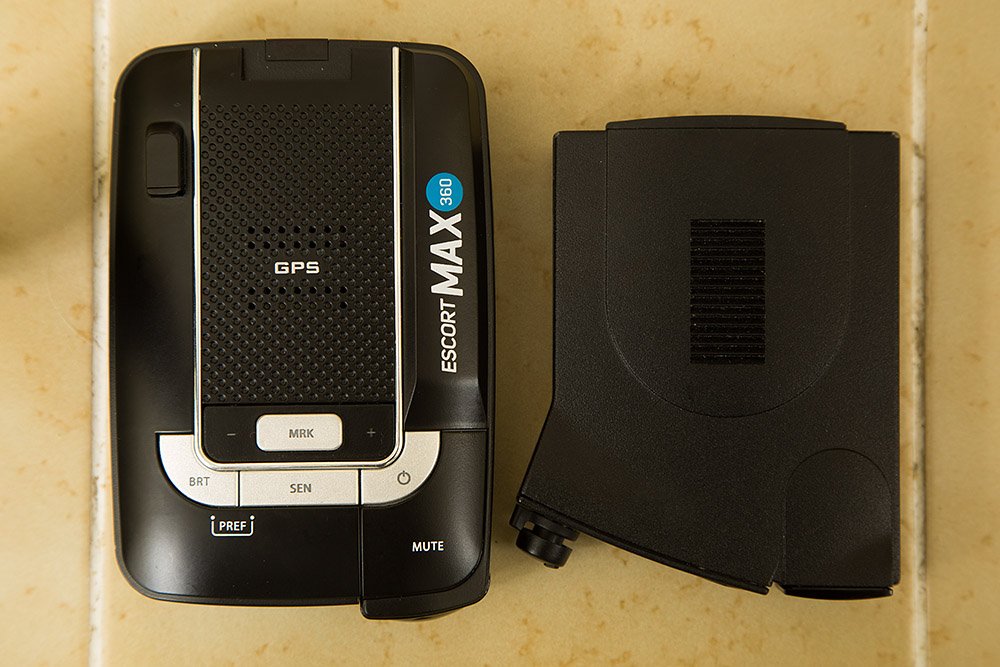
The V1 is more compact. The Max360 is larger and bulkier.
The V1 weighs 6.4 oz and the Max360 almost double at 11.2 oz.
Mounts
While the Max360 is large, I find any size issues to be more due to the mount than the detector itself.
In my little Miata, the Max360 blocks some of my visibility looking out. The sticky cup holds it down low, further down into my line of sight. The fact that the detector hooks up at the back means that it sticks farther forward towards me too and blocks more of my view in my rearview mirror.
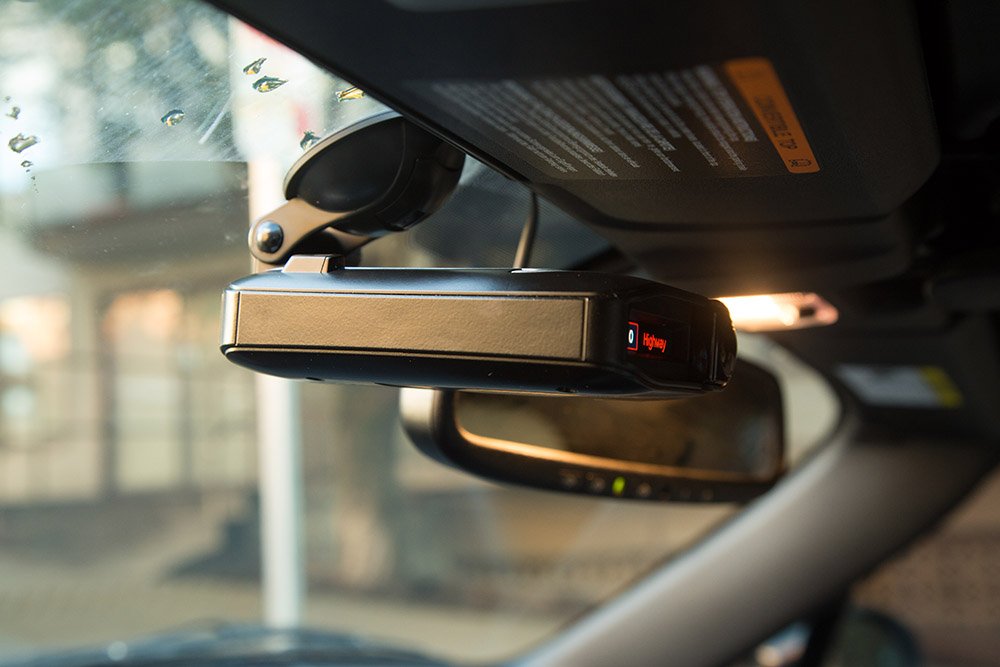
The V1 is not only more compact as a detector, but the mount lets it rest much higher and the fact that the mount connects in the middle of the detector means that I can push it away towards the windshield more and so it’s less in the way of my vision, even in a small vehicle.
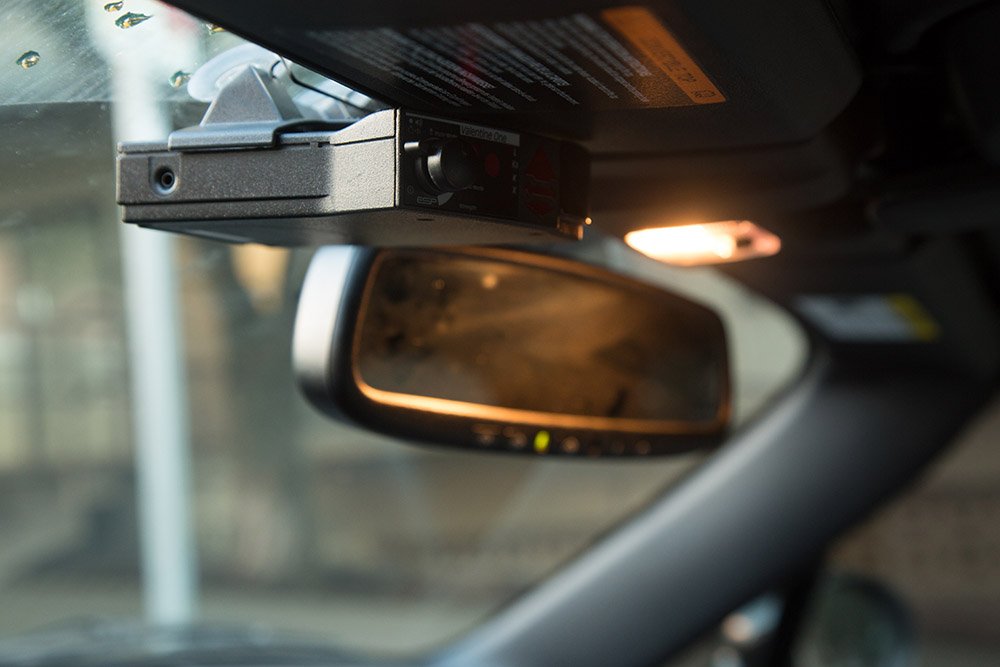
In a larger vehicle, this should be an issue.
The V1’s mount has long been one of my favorites. Very easy to mount and unmount, very adjustable, and holds well. After a few years the suction cups may start to get flattened and lose their suction like any suction cup, but otherwise it does great.
The Max360’s sticky cup mount is a little different. It features a magnetic connector to hold onto the detector and there’s no release button anymore. Makes it super easy to mount and unmount. One of my favorite mounting techniques.
Instead of a suction cup, it uses a sticky rubberized pad that acts kind of like a suction cup. It really needs a clean surface in order to work properly and if your windshield or sticky cup is dirty, your detector will fall off your windshield. Make sure you clean your windshield and rinse off the sticky cup if it’s dirty.
Previous generation sticky cups were known for their unstable mount and the detectors bouncing all over the place. The updated sticky cup for the Max360 has largely solved this issue. However, it has introduced another issue with the sticky cup itself actually falling apart. There is a weakness in the latch you use to attach and remove the sticky cup. If it pops off, the spring inside the sticky cup makes the whole thing fly apart and your detector will come crashing down. This has happened to several users so far including me. You can see the problem here.
Price
The V1 retails for $400. The bluetooth adapter you’ll need for YaV1 is $50. You can use your existing Android phone or buy an inexpensive prepaid phone like this one, never activate it, and now you have all the different pieces of the kit you need to have a V1 with YaV1.
Note: I recommend buying a new V1 straight from the factory. They only sell direct. Unlike the Max360, I’d avoid buying a new V1 from Amazon. If you do, you’ll be paying more than full price (click here if you want to see), plus you’ll get no warranty. Amazon is one place where people can go to buy the V1 if they live abroad since Valentine doesn’t ship internationally. It’s also a place where people go if they don’t know and automatically buy everything there. Nothing wrong with Amazon of course. I shop there all the time. However, for the V1, it’s best to get it direct. If you want a bit of a discount, call up Valentine and ask for a returned unit. They sell them for 10% off when they have them in stock. If you want to buy a used one, while I’d recommend against that in general, watch this video to learn everything you need to know.
The Max retails for $650. This one is simple and straightforward. Go to Amazon and buy a Max360 there. Doing so also supports me and I make a percentage when you buy from them.
Conclusion
Both detectors have a lot to offer and they share many of the same features. The Max360 is designed to be more intuitive, plug-and-play, and easy to use. It’s ready to go right out the box. The V1 is pretty limited compared to the 360, but if you’re comfortable with phones and apps and don’t mind running a phone app or two, you can get just about everything the Max360 offers in a higher performing, more refined, less expensive package.
Personally I think the V1 is a better choice, but for those who are looking for something easier to use and doesn’t require you to have to know as much about radar detectors to operate, Escort now has their own version of the V1/YaV1 available. Both have their place. You get to decide which approach you prefer.
| This website contains affiliate links and I sometimes make commissions on purchases. All opinions are my own. I don’t do paid or sponsored reviews. Click here to read my affiliate disclosure. |

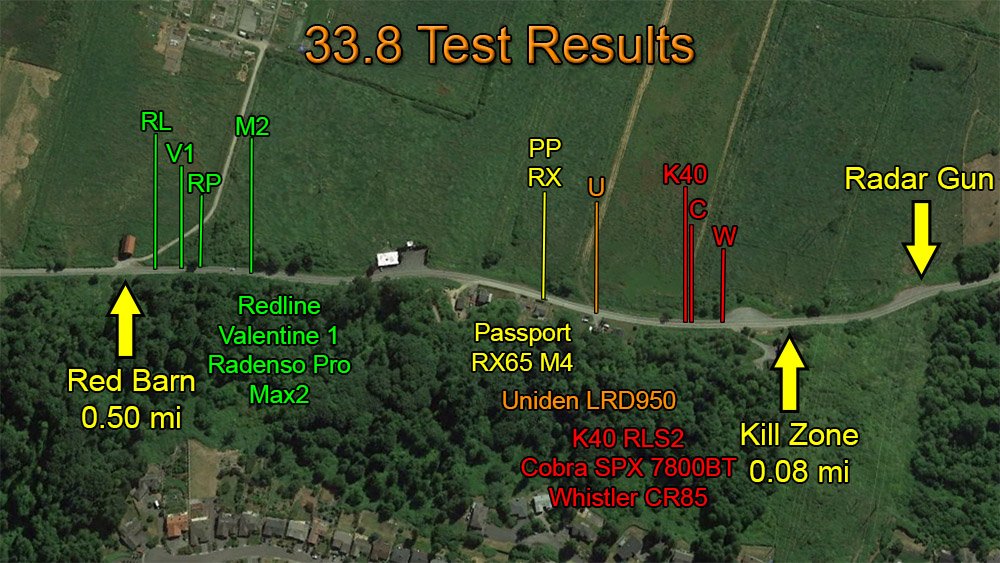
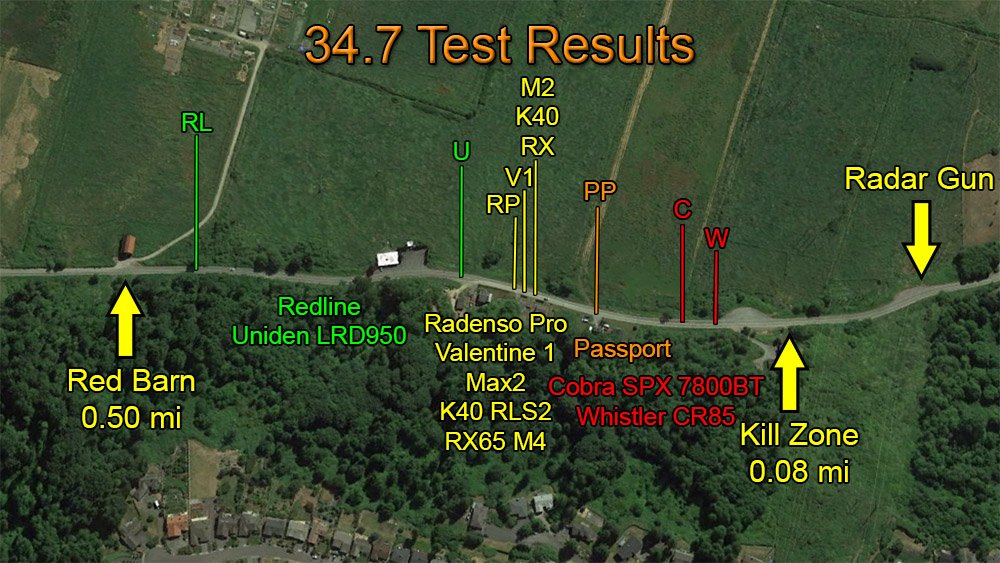
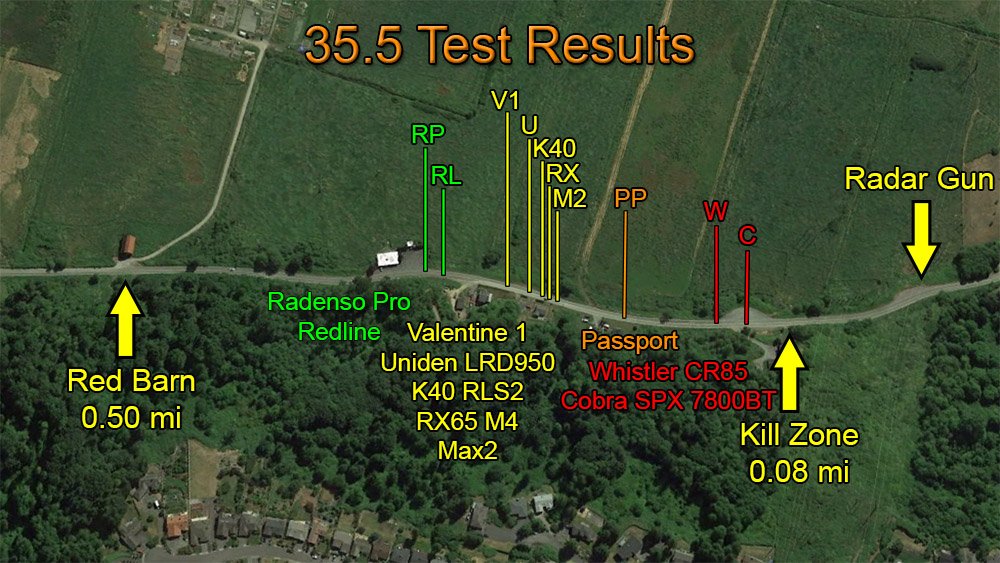
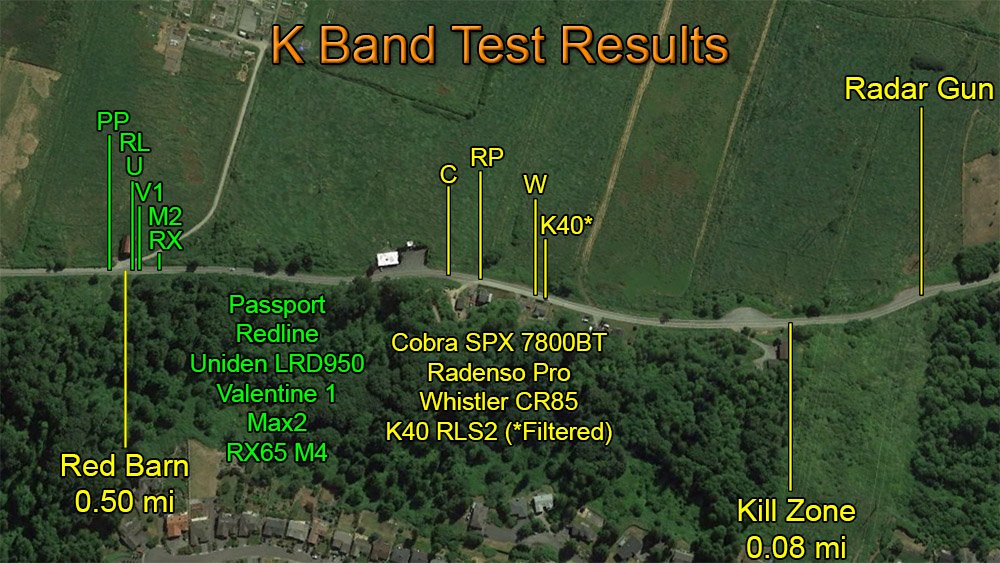

33 comments
Skip to comment form
nice write up. what about a BEL STiR Plus vs the YaV1 vs Escort max360 for radar protection?
I am strongly considering adding ALP for laser protection.
Author
I’m working on a review of the Plus right now, speak of the devil. 🙂 It’ll give you better performance than both, GPS lockouts built in like the 360, but no arrows and the blind spot filtering isn’t quite as good.
It’s a good option for a remote detector.
ok thx.
If I go the YaV1 route, do I need to have the android phone visible on the dash or can I just have it out of sight as I typically put my iPhone running Waze on the dash. I don’t want too much clutter on the dash in front of me.
Author
You don’t need it visible. You’ll need to first make sure that it launches and connects to your V1 which it may not automatically do if it’s in your pocket. Once it’s connected, you’re fine. You won’t see the frequency information for your signals which is useful information, but all the muting and performance stuff will be there no problem.
appreciate the reviews, and your candor. I find the V1 to be incredibly frustrating with the amount of false alerts and the custom tuning required to get a reliable detector. I have no experience with the 360 to say if it does or does not have similar issues, but the V1 has done two things for me. It has basically trained me to ignore it all together and distracted me from my actual driving because it goes off constantly.
I have the latest hardware model, but do not have the Junk-K filter firmware.
Just my biased opinion, but even if the v1 is 30% cheaper than the 360 I feel l like the end user is expected to finish their development work to make the v1 a more reliable product. Call me ignorant or a neanderthal but I’d prefer the more turn key option.
Author
Yeah I totally get that. The new V1’s Junk-K filter is a big improvement over the previous version, but if you want something more turn key, that’s what the Max360 is all about.
Thanks for this GREAT review. Clearly you’re someone who is very familiar with both devices. Based on your review, it’s clear that I would stay with my existing V1; however, for my wife (READ: Give me something I don’t have to worry or think about…) I’ll order the Max 360.
Of course I’ll order through your channel so you get a commission.
It’s the least I could do for your time in putting this review together.
🙂
Cheers,
-Tony
Author
Thank you! 🙂
Dear Sir,I have now owned the Max,Max2,and now Max 360. I been terribly disappointed with the radar detection. And the laser is virtually useless,as I am sure y’all are well aware.
This is my main problem now with the Max 360. The laser alert constantly false,even when there is no laser anywhere. I talked to Escort,they said to replace it,which I did. Second Max 360 has the same identical problem. It’s already scary enough,to not have any confidence in your radar/laser? detector. I know I can’t be the only one with this problem. Thankfully,I live in a part of Alabama where they aren’t using laser yet. But when I drive to Birmingham or Georgia,the laser is intermittently falling. Escort told me ,I would have to send it in ,so they can recalibrate it and I would need an RF filter. All of this will lower the already poor detection. I feel like I ,like many others are being sold an inferior product at extravagant prices. What is wrong with this picture? Please help me understand.
Hopeless in Alabama
Author
That is strange about the laser falsing. Mine are pretty good at managing the laser falses, but I have heard of that happening to one or two other people as well. It’s not normal though.
The Max’s are definitely easy to use radar detectors, but radar performance and long range is where they’re weakest. If you want better performance, you’ll want to switch to another detector that’s more about higher performance.
If you do decide to get a set of laser jammers, and you’ll want to if you need protection in GA where they run a ton of laser, you’ll want to get a set of ALP’s.
Good morning. For the price point and performance. What built in radar system would you suggest and should I forgo there laser system for ALP.if so do I need front,rear,side on alp.I’m on disability due to a spinal injury and 3 surgeries and I have 3 small children.but with the insane increase in ticket prices and 3 year hike in insurance rates seems like 1-2 saved tickets is saving you in real life terms $1500.this would be on a 2096 honda pilot with lots of square reflective surfaces.I would like something as close to stinger performance with best laser.and when being painted with laser what exactly happens to keep me from getting a ticket.and if I have a different companies built in radar system snd adding ALP for instance what would I see on my radar readout?
Off this topic having the max 360 w/escort live on a Samsung galaxy Note 4 and my head unit is a kenwood DNX890HD with built in garmin nav.and it connects to my pg one via Bluetooth can I connect my phone to kenwood while my 360 connected to live?so I can see live on 7″ kenwood screen.I’m sure a ton of people would like to know that.how many people have the double din screens in there vehicles right now.and how cool would that be to look at that big screen instead of phone.and it would look less clunky on the dash.Thank you for your time in answering my questions. Bradley
One thing that V1 has done for me is TRUST . Yes the system looks old and unattractive but in the end after owning three and several upgrades since 1999. Is going to take a lot more than GPS ,bells and whistles to get me to try and recommend something new with no proven track record ….LMTZ …..TX….
I just wanted to know what type of mount you use to mount your smartphone for the YaV1 app on your Android device. From all of your videos, it looks very sturdy and allows you to securely mount your Android device without any vibration and has a low profile. Additionally, do you know where I can find the best settings for my newest V1 with the YaV1 app in Florida? Any assistance would be appreciated.
Author
I use the RAM X-Grip mount for my phone currently. http://amzn.to/1dwz7Pz
Review video: https://www.youtube.com/watch?v=fXeYWZtiuoc
As for programming your detector for Florida, watch this: https://www.youtube.com/watch?v=n2UIfQUGqUE
Thank you very much! You are very dedicated and are objective in your reviews, which is an added bonus for your Great Vids! Thank you agrain for all your hard work!
Good evening. I’m new to subscribin to you although I have watched tons of your videos.you explain very well.my wife has max 360 because she drives in city.I have the redline (which I got with the hard mount android Bluetooth smart cord for $316.00 new off Craigslist. Is that pretty good deal ).anyway she has a 06 honda pilot.I went with max 360 since she drives in town most on the way to school she is a kindergarten techer.and I got redline because seemed like a good deal.it’s in a 98 jeep cherokee. After we get our taxes back in 2017 I will get her a used honda odyssey touring (I can get for $5500-6500)and cosider in new they were $45,000 that’s good price even though it’s 10 years old it has all bells and witless and it is a honda.they last forever.I’m on disability due to a spinal injury and 3 surgeries and we have 3 kids.both the pilot and the odyssey are very large vehicles.what would be the cheapest built in radar detector and API jammer set up.I want the radar detector to be invisible for when we go to races in virginia,and want radar to block out known false alerts like the max 360 and also want rear radar as well a’s front and laser receivers to be sure to cover all areas.if you would please give me your opinion on most economical set up for what we want.and since we are on such tight budget are there every any situations you come across where these items are used or open box or demo models. I would really really appreciate all your help.if I can’t find where you have responded to this post would you please email me. (I can give you my personal email.
Again thank you very much.I used to have alot of hobbies until my accident but for 4 year’s it has been car audio and latley detectors and jammers.by the way you do an awesome service to this country with your technical reviews and help.I was a certified master yamagata and mercury outboard mechanic.used to build racing motors for 18 years.went from adrenaline driving a boat at 120 mph for testing to car audio and radar.it has been more fun than I thought.I’m just trying to find a way we can afford it techer even with masters degree and teachung the future of our country just don’t make much and disability checks are a 1/16 of what I made…Brad
P.S. please help if you know a way I can get this setup for much less for 2 vehicles or if there is a way I can pay for both setups each month until payed off then it will be shipped so the there would be no risk because I would be making payments while the product is still in the sellers hands along with my payments and it would not be shipped until payed in full..please help.the Sidwell Family.
Author
Hey Brad! Thanks for the message.
So let’s see…
As far as the ALP, you’re gonna need 3 heads minimum up front for each vehicle. You can add 2 more rear heads later at any time.
For the RD, the STi-R Plus is the only fully integrated remote RD for the ALP that’s fully stealth to radar detector detectors. It’s got great performance but it’s blind spot filtering on K band is only so-so. The new Net Radar doesn’t have quite the level of performance as the Plus and it’s detectable at very close ranges, but the blind spot filtering is much better.
Getting a used jammer is sometimes an option, but they are rarely sold for much of a discount due to demand and limited availability of used units. As far as a payment plan, contact Tom directly. https://www.alpriorityusa.com/crm.asp?action=contactus I don’t know if he offers any sort of payment plans, but he’d be the one to talk to to work something out.
Thanks you very much for your response.if I go with your redline setup which turns it into the so called xr and pair it with escort live will it block out false alerts as I drive around my town going past the same stores with auto door openers,ect like the max does?.I guess I’m asking if the smartphone controls the redline and tells it not to audible alert when it sees the same alert going off in the same place.also just wondering why don’t detector companies find out what frequency the car companies use for there car sensors and use them in updates.they could even add what type of vehicle.it wouldn’t be difficult to find out with testing if they wouldn’t give info out.that would 100 percent block all false from car sensors. Thanks for your help…Brad
Author
So configuring the settings built into the Redline won’t actually help with door openers. You see, to filter those out, you need to learn where they are and that requires a GPS chip. Since the Redline doesn’t have one, you need to pair it with your phone and run an app on your phone which adds that functionality. You can buy an Escort Live bluetooth cable to pair your Redline to your phone and then press a button in the phone’s app to tell it this is a stationary false alert and for the app to mute your detector next time you see this signal in this location again.
As for filtering out blind spot falses, it’s very tough to do, especially since the frequencies used by blind spot sensors and police radar guns can be identical. To filter those out, detectors need to do more sophisticated scanning and analysis to recognize the differences between different signals (easier said than done), but some of the newer detectors are getting pretty good at doing this.
Ok.I understand I just thought if they were found to definitely found to be k band and not used by a large majority of police they could filter them out but the companies would have to get lists of frequencies from each car manufacturer.they could at least block out ones known to be far from police ones.just a thought.so I can block out the stores around my house by pushing a button on my phone by using my escort live hard wired set up I have now.can I also adjust settings on phone instead of going through all the settings by pushing buttons on tedline?using your tutorial on making mine a xr.does it reallyake the redline a much better detector? When I’m able to I’m going to go with the stir you recommended and alp.boy each extra jammer antenna is exspensive. Why is the stir better than the 9500ic?thought they were about the same..again thanks..Brad
Author
Yeah unfortunately it’s much more complicated than that in practice. If you have Escort Live already, then yeah definitely run the app and use the lockout button it offers.
Custom programming a Redline significantly helps make it a faster reacting and longer range detector. That’s the main benefit.
The STi-R Plus is better than the 9500ci because it doesn’t come with the 9500ci’s inferior laser jammers. That said, if you’re getting the ALP’s, take a look at the new Net Radar antenna. Performance isn’t quite up to par with the Plus, but the blind spot filtering is significantly better. The Plus has lockouts that are totally automatic while the Net Radar’s lockouts require a phone and they’re manual like your Redline.
If you had a choice of only a max 360 or a redline which would you choose?
Author
Max360 in general. Redline if you’re specifically driving in rural backroads and highways.
Thanks for all your help.your very very well informed and I like how you break things down in easy to explain terms.I think although the net has better false blocking the other features for… me out way the net.can I get the stir without anything except just what I need for radar and gps,so I can add the alp.do I need that big speaker or does it alert with a built in speaker or can I use stereo speakers or is it just best to get it.I wonder why they make it soooo big.you could have it the size of a tweeter and get plenty of decibels. If you personally would ever be interested in a trade for some JL AUDIO equipment for a stir maybe you don’t use anymore or alp.I know you have alot of radar laser stuff and thought maybe you were not using.I would be more than happy to ship first.then after you revived the package from me then you ship.that way you wouldn’t have anything to worry about.I have been a ebay member for many years and have over 400 transactions with 100% positive feedback. So your welcome to check me out on ebay.since I’m on disability with 3 kids and wife that teaches kindergarten we are on tight budget and I’m always lookinG for a way to trade.thanks.
Is Escorts version of YaV1 and the app, as refined and high preforming? I really am having a hard time deciding what I would like. I truly enjoy the V1 and like the app pared with it. However, I’m not that tech savvy and if the escort with the app if just as refined as the YaV1 I may look into that. I’d be willing to take the time into the V1 and learn a bit more, but I’m not exactly sure what to do. I kind of have a heavy foot so either I imagine would help me in the long run. Also do either of these companies make any sort of detector for a motorcycle?
Thanks! Great videos and write up!
Hi, I had a 12 year old V1 that I sold. Never upgraded it. Now I have to drive a lot for work. A lot of highway, but with alot of traffic. I am trying to decide between the V1 /YaV1 or the Radenso pro se. I get the sense that all of the ones in that price range provide adequate radar protection. One being a bit better may not be significant in the real world. What will drive me crazy is blind spot/ traffic detectors. Based on that, which set up would you go for?
Thx!
AA
What happens to each detector if your actually driving a car with blind spot monitoring on it? Are either of the detectors even usable? If so, Can you filter them out with out a detection range loss?
Author
Which vehicle do you drive? Some will affect your detector and some won’t. This can really vary between vehicles because there’s sooo many types of blind spot systems out there. It may cause endless false alerts on your detector and be a problem, but hopefully it doesn’t.
Thanks for the Message! Wife has a 2015 Yukon Denali. I have a 2015 Ford F-150. Both have Blind sport monitoring.
My older version V1 goes nuts on the wifes Denali as is. Will the update help it?
Author
Oh yikes, those Denalis can be rough. They make virtually every detector out there false alert. GMC’s are notoriously difficult to filter out. The only solution that I’ve seen for those is the Stinger VIP which offers an in-car radar filter. It will recognize the blind spot false coming from your vehicle and filter it out separate from everything else.
Your F-150 should be fine though. It won’t cause false alerts with other detectors, thank goodness. 🙂
DANG….Thanks for the reply. Back to the drawing board.. ha ha
GREAT website!
JUST FYI… Turning pop off on the V1 version 3.872 does in fact quiet it down around the Denali. I read from some of your other posts that POP on a V1 actually reduced K signal and causes more falsing. I find this very true so far.
I can testify from running around town today the V1 is MUCH improved on false signals! Hopefully it stays that way. May not need to keep the Max 360 I just bought.
I have pop on the 360 turned off as well. Seems to be a signal killer/causes falsing on both machines from you posts. This true?
detects rooms with fixed radar?
valentine 1?